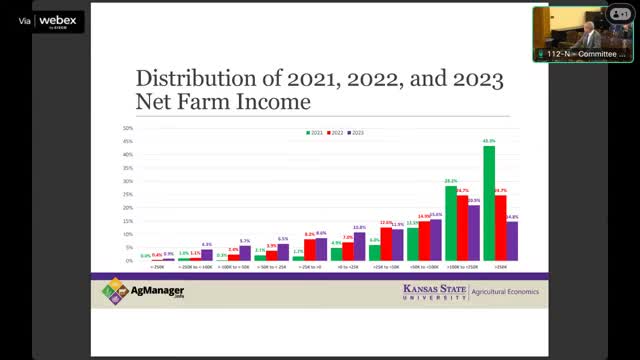Kansas farms face rising financial strain as net income drops to one in four farms
January 16, 2025 | Committee on Agriculture and Natural Resources, Standing, HOUSE OF REPRESENTATIVES, Committees, Legislative, Kansas
This article was created by AI summarizing key points discussed. AI makes mistakes, so for full details and context, please refer to the video of the full meeting. Please report any errors so we can fix them. Report an error »

Kansas farmers are facing significant financial challenges, as recent data reveals a troubling increase in the number of farms reporting negative net income. During a meeting of the House Committee on Agriculture and Natural Resources on January 16, 2025, experts highlighted that the ratio of farms with negative income has surged from 1 in 20 in 2021 to 1 in 4 in 2023. This alarming trend suggests that nearly half of the farms are struggling to meet the basic living expenses of their families, with only 50% able to earn the $50,000 needed to support their households.
Despite these challenges, the overall debt situation for Kansas farms has remained relatively stable, averaging around $750,000 per farm. However, there has been a noticeable increase in current liabilities, indicating that farmers are relying more on short-term borrowing to sustain their operations. The average debt rose by approximately $50,000 from the end of 2022 to the end of 2023, primarily due to increased current liabilities.
The liquidity of farms, which measures the ability to cover short-term obligations, has also deteriorated, dropping from 13-14% to about 11%. This decline raises concerns about the financial health of these operations moving forward. Experts predict that unless there is a significant improvement in commodity prices for key crops such as corn, wheat, sorghum, and soybeans, the liquidity situation may worsen in 2024 and 2025.
The committee's discussions underscored the urgent need for strategies to support farmers during this challenging period, as many are struggling to maintain their livelihoods amidst rising costs and decreasing income. The implications of these financial trends are critical for the agricultural community and the broader Kansas economy, highlighting the importance of continued monitoring and potential intervention to stabilize the sector.
Despite these challenges, the overall debt situation for Kansas farms has remained relatively stable, averaging around $750,000 per farm. However, there has been a noticeable increase in current liabilities, indicating that farmers are relying more on short-term borrowing to sustain their operations. The average debt rose by approximately $50,000 from the end of 2022 to the end of 2023, primarily due to increased current liabilities.
The liquidity of farms, which measures the ability to cover short-term obligations, has also deteriorated, dropping from 13-14% to about 11%. This decline raises concerns about the financial health of these operations moving forward. Experts predict that unless there is a significant improvement in commodity prices for key crops such as corn, wheat, sorghum, and soybeans, the liquidity situation may worsen in 2024 and 2025.
The committee's discussions underscored the urgent need for strategies to support farmers during this challenging period, as many are struggling to maintain their livelihoods amidst rising costs and decreasing income. The implications of these financial trends are critical for the agricultural community and the broader Kansas economy, highlighting the importance of continued monitoring and potential intervention to stabilize the sector.
View full meeting
This article is based on a recent meeting—watch the full video and explore the complete transcript for deeper insights into the discussion.
View full meeting
